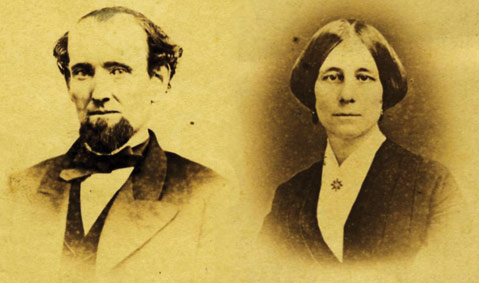Kimberly Avenue
Who Was the Street Named After?

Kimberly Avenue, a short thoroughfare that bisects the block bounded by Yanonali, State, Mason, and Chapala streets, was named for a family whose involvement in the history of Santa Barbara dates back to the 1850s. Martin M. Kimberly arrived in Santa Barbara in 1854. He came to California in the early 1850s and initially settled in San Francisco. Taken ill by copper poisoning, his physicians recommended the gentler climes of Southern California for his recovery. Kimberly and a friend then made their way to Santa Barbara.
A seafaring man, city life did not agree with Kimberly, and he relocated to Santa Cruz Island, where he lived for three years. While on the island, he was introduced to otter hunting. At that time otter pelts sold for about $25 apiece. William Barron bought Santa Cruz in 1857, and Kimberly moved again, this time to the even more remote San Nicolas Island. Here, he successfully turned to sheep ranching. Unfortunately, a drought in the mid 1860s that devastated the ranching industry throughout California also virtually destroyed Kimberly’s island operation. He sold the remnants of his stock and divested himself of his island holdings in 1870.
In 1865, Kimberly had married Jane Merritt. Born in New York, Merritt grew up in Texas before her family relocated to San Francisco in the early 1860s. Her father, P. G. Merritt, had arrived in San Francisco in 1855 and became the editor of the first Republican Party newspaper in California. Eventually, he published six different newspapers and was a member of the second Committee of Vigilance in 1856, which took justice into its own hands, holding trials, and, at times, meting out capital punishments in an effort to “clean up” San Francisco.
The newlyweds initially set up housekeeping in the St. Charles Hotel, originally the Alpheus Thompson adobe, in the 800 block of State Street. This two-story building was one of the first Monterey-style adobes in California. Jane Kimberly threw herself into the social whirl of the small town. She was a member of the committee that established the first Episcopal church here. The committee raised money for a church building by holding a fair, the outstanding feature of which was to serve what reportedly was the first ice cream ever seen in Santa Barbara. The new Episcopal church opened its doors on Christmas Day, 1868, in the first block of East Gutierrez Street. According to her daughter, Jane Kimberly suggested the name “Trinity” for the new house of worship.
The couple eventually moved to an adobe on the 100 block of State Street. Kimberly again turned to otter hunting, the profession he had first taken up while on Santa Cruz Island, to support his growing family. For the first few years, he hunted the waters off of California, but as the otter population shrank, he was forced farther out into the Pacific. By the 1870s, he was hunting the elusive mammal off the coasts of Siberia and Japan. On an ill-fated trip in 1878, Captain Kimberly’s ship went down with the loss of all hands. His widow now faced the prospect of providing for two small children on her own.
Friends came to the rescue. The Dibblee family offered her a 22-room house at Haley and Chapala streets at a modest rental where she could take in boarders. The White House proved quite successful. Utilizing this experience, Jane Kimberly managed the Hot Springs Hotel in the hills above Montecito off and on in the late 1880s and early 1890s. In the early 1900s, Kimberly received a sizable settlement from Southern Pacific when the company condemned some of her property to realign the rail line. This allowed her to build the Kimberly Apartments at 104 Chapala Street. According to her daughter, Jane Kimberly was a bit of a hypochondriac, always complaining about ill health. Yet she lived to the ripe old age of 96, dying in 1936. Kimberly Avenue memorializes her family’s long history in Santa Barbara.



